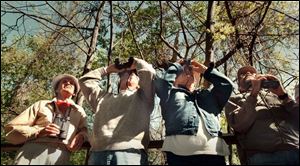
Budget crunch at Crane Creek will aid birds, birders
5/18/2008Crane Creek State Park, a little vest-pocket public parcel offering swimming and picnicking on a wooded beach ridge in western Ottawa County, has been closed, its 40-odd acres turned over to the Ohio Division of Wildlife.
The park was surrendered by the Ohio Division of Parks and Recreation as part of long-term retrenchment in the face of
continuing budget cuts.
The closure and subsequent transfer of land management responsibilities to managers at 2,000-acre Magee Marsh State Wildlife Area, which surrounds the former park, became
official this month, according to spokesmen for both state
divisions.
The park sign, which was posted underneath the Magee Marsh sign on State Rt. 2, has been removed and the beach restrooms have been locked. The plan is to remove the restroom building and equipment, plus picnic tables and grills, for use elsewhere within the parks system. The wildlife division plans to provide portable toilets according to seasonal needs, including in winter to accommodate ice fishermen.

This could be the scene at Magee Marsh Bird Trail during May of any year as avid bird spotters scan the trees for warblers.
No picnicking or swimming will be permitted, though parking lots likely will be maintained to handle the thousands of birders who flock to the famous Magee Marsh Bird Trail and surrounding environs each spring to observe the waves of migrating neotropical songbirds.
Mark Shieldcastle, wetlands project leader at Magee, said that a management plan is being worked up, but any plans will include public comment opportunities.
It may take a decade of natural recovery, he said, but the 40-acre expansion of beach-ridge habitat now devoted to park will double or triple what will be available to migrating birds.
Magee and the adjoining
Ottawa National Wildlife Refuge just to the west are rated among the top birding sites in North America. Birders travel great distances to be on the western Lake Erie shoreline in the spring to see up to 300 species of large and small birds, from bald eagles and shorebirds to very rare Kirtland's warblers and tiny flycatchers.
The division plans to allow the current wooded lakeshore beach to revert to a natural wooded beach-ridge, with some expansion of birding trails but also with off-limits refuge zones.
"It's going to be exponentially important to the birds," Shieldcastle stated. A reverted beach-ridge on the park site will serve as a wind buffer to protect hundreds if not thousands of resting migrant birds, which tend to halt at the lakeshore to rest and feed before taking on the nonstop flight across the lake. The wind buffer is "very, very important," the biologist added.
The reconstituted shoreline furthermore will create a low-maintenance habitat corridor all the way to Ottawa refuge.
"It's going to fit well with our management plans for wetlands and migratory birds and [also] supply recreational uses," Shieldcastle said.
John Daugherty, manager of Ohio Wildlife District 2, said that the parks administration had looked at what to do with Crane Creek for a number of years and that the wildlife division all along showed a strong interest "because of the massive amount of opportunity for birding."
He noted, for example, that an estimated 6,700 visitors came to Magee on International
Migratory Bird Day on May 10. He personally observed 197 cars in the lot by the boardwalk-equipped Magee Bird Trail, which adjoins the former Crane Creek parkland but always has been Magee wetland, on a recent Wednesday afternoon. "That doesn't happen anywhere," he said, illustrating the intensity of birding interests.
Daugherty also envisions increased fishing opportunties on the lakefront as well, though he stopped well short of suggesting a fishing pier, which likely would be prohibitively expensive. "I am sure there is some pretty good catfishing there," he said of the beachfront.
Swimmers and picnickers now will have to use Maumee Bay State Park, west a few miles down the lakeshore in eastern Lucas County, or East Harbor State Park on Catawba Island peninsula northeast of Port Clinton for Lake Erie recreation, said Daugherty.
Dan West, state parks chief, said that the availability of Maumee Bay State Park nearby made the decision somewhat easier, at least as far as providing swimming and recreational beach opportunities.
He noted, however, that Crane Creek was deemed expendable in an era when state parks have been faced with one biennial budget slash after another. The parks division operates, for example, with less than half the staff for 74 parks that it did in 1991, West noted, and is limping along with more than $500 million in deferred maintenance on its 2,700 buildings and structures.
The reason for such capital woes, in short, is that state lawmakers and governors have been too pressured by other seemingly higher economic priorities to address - from health and highways to schools and social programs - to find much left in the general revenue funds.
Funding alternatives, moreover, have been slow to develop. The ill-fated Parks Pride Pass, an initiative floated by the Republican Taft administration, quickly was pronounced dead on arrival by state lawmakers and segments of the public opposed to levying anything resembling entry fees on parks visitors. So the parks have continued to suffer while being taken for granted.
Tuesday - The demise of Crane Creek State Park is just a miner's canary for a state park system facing a long-term
economic crisis.
Contact Steve Pollick at:
spollick@theblade.com
or 419-724-6068.